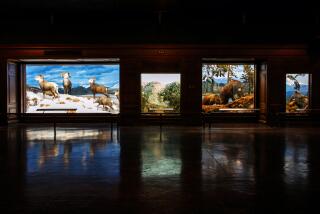For the Birds
- Share via
Road kill--it’s not what you’d expect at a museum. But there it is on a chunk of highway, complete with the yellow line: Three hulking vultures ripping the guts out of a dead opossum.
This realistic bit of whimsy is part of a large traveling exhibit on birds of prey that has just winged its way to the Santa Barbara Museum of Natural History.
This is no dreary, bookish study of birds. The drama, humor and realism will hook kids. The blood-and-guts road kill scene even has flies.
“Everyone gets grossed out,” said Paul Collins, a senior associate curator of vertebrate zoology at the museum.
What’s neat about the entire show, he said, is that many of the birds--eagles, hawks, condors, falcons, owls, vultures--are mounted in active positions that show them in real-life situations amid natural surroundings.
Like the great gray owl on a snowbank, clutching a mouse in his mouth. On the backside of the exhibit, another mouse is hiding in a tunnel.
It’s this touch of whimsy that makes it fun. Kids can go into a computerized “hoot booth” and listen to a dozen kinds of owls. Then they can record their own imitation of the hoot and play it back. And don’t think one hoot is the same as another.
“They can hear owls that chirp,” Collins said.
The show, here through Sept. 7, is so large that it spilled out of the museum’s auditorium and into other exhibit halls.
Called “Hunters of the Sky,” it was produced by the Science Museum of Minnesota, along with the Raptor Center at the University of Minnesota.
And speaking of big birds, the bald eagle is a beaut. In one scene, a nest the size of a hot tub rests on the branches of a pine tree set against the backdrop of a huge lake.
Two eagle chicks are in the nest with the mother, while the father is flying in with a fish in his mouth.
Like some of the other bird exhibits, this one details the bald eagle’s struggle for survival against the pesticide DDT.
It also clears up the mystery of why this bird is called “bald” when its snow-white head is anything but bald. (Get this: In some convoluted way, “bald” evolved in English from the French word for white--”blanc.”)
Of course, the condor is a major player in this show, and visitors can learn about the costly breeding program aimed at bringing these huge birds back from the brink of extinction.
At a computer station, they can even participate in a poll on the value of this program.
There are lots of touchy-feely things for young children to do.
They can see firsthand how baby condors are fed by keepers using condor puppets so the little chicks won’t imprint on humans.
They can stand against the wall and spread their arms to see how small they are compared to the 9-foot wingspan of a condor.
They can experiment with the wind tunnel machine and fake wings to see how the birds get a lift from the air.
Kids can also see just what these birds of prey call dinner. In one exhibit, a short-eared owl is next to a mound of 800 dead meadow mice--the bird’s diet for a year.
In another, different birds are lined up, and in front of each is a china plate containing its diet.
For the black vulture, it’s a dead gray squirrel; for the red-shouldered hawk, it’s a smorgasbord of snake, bird, spider and fish.
For those who might be worried about how all these birds left the wilds, they can rest easy that none was purposely killed for this show.
The exhibit halls are plastered with signs explaining that all the deaths were accidental, such as electrocution from power lines or being hit by a car.
In conjunction with the exhibit, the museum has several special events planned through the summer.
If you want to see the real thing, live birds--eagles, hawks, falcons, owls--will be on hand for Sunday shows, June 14 and 28 and July 12 and 26 at 2 p.m. On June 18, a program about the Chumash and birds will be offered at 2 p.m.
On Father’s Day, June 21, the museum will screen “Gifts of an Eagle,” filmed in the mountains above Santa Barbara.
Captured as a baby with a special permit, “Lady” was raised by the Durden family and stayed for 16 years before leaving for the wilds with a mate.
The film, shown at 2 p.m., tracks the bird’s relationship with the family over the years.
Families will find other bird-related activities at the museum, such as visiting the raptor station in the afternoon to look at feathers, bones and talons or dissecting owl pellets at 2 p.m. on Saturdays.
Throughout the summer, the museum will offer storytelling, live music and planetarium shows--all with a bird connection.
BE THERE
Santa Barbara Museum of Natural History, 2559 Puesta del Sol Road, Santa Barbara. Monday through Saturday, 9 a.m. to 5 p.m., and Sunday from 10 a.m. to 5 p.m. $5 (teens and seniors $4, and children $3). (805) 682-4711.
More to Read
Sign up for The Wild
We’ll help you find the best places to hike, bike and run, as well as the perfect silent spots for meditation and yoga.
You may occasionally receive promotional content from the Los Angeles Times.






